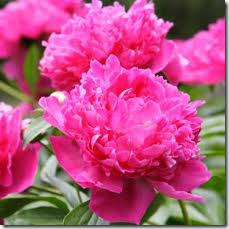 Garden peonies, known botanically as Paeonia officinalis, are herbaceous flowering perennial plants that produce beautiful single, semi-double, double, Japanese, and anemone-shaped blooms in a variety of dazzling colors. Since they require between 100 and 300 hours of cold winter temperatures to bloom, peonies can be grown in USDA plant hardiness zones 3 through 8. Peony root divisions grow best when planted in the fall, while potted peonies prefer to be planted in warm spring weather.
Garden peonies, known botanically as Paeonia officinalis, are herbaceous flowering perennial plants that produce beautiful single, semi-double, double, Japanese, and anemone-shaped blooms in a variety of dazzling colors. Since they require between 100 and 300 hours of cold winter temperatures to bloom, peonies can be grown in USDA plant hardiness zones 3 through 8. Peony root divisions grow best when planted in the fall, while potted peonies prefer to be planted in warm spring weather.
- Difficulty:
- Moderately Easy
Instructions
Things You’ll Need
- Potted peony or peony root division
- Shovel
- Spade
- Aged manure
- Peat moss
- Coarse builder’s sand or perlite
- 10-10-10 fertilizer
- Garden hose or watering can
- 5-10-10 fertilizer
- Pruning shears
- Choose a planting location in your garden or home landscape that meets the sunlight and soil requirements of your peonies. Select a full sun location that provides them with six to eight hours of direct sunlight each day. Look for a location that offers well-draining soil, or amend the soil to make it more suitable.
- Clear the entire planting location of grass, weeds or other vegetation that will compete with your peonies for moisture and nutrients. Dig deep to remove the root systems of the unwanted vegetation or they may reemerge.
- Amend the soil to make it more hospitable for your peonies. Spread a 3-inch layer of equal parts aged manure and peat moss over the surface of the soil. Add a 1-inch layer of coarse builder’s sand or perlite to amend and improve soils that do not drain well. Work the organic amendments into the soil to a depth of 12 to 15 inches.
- Dig planting holes that are approximately 18 inches deep and of an equal width. Space multiple planting holes at least 3 to 4 feet apart to allow adequate room for your peonies to grow. Add a 1/2 cup of granular 10-10-10 fertilizer to the bottom of each hole. Backfill the hole with the displaced amended soil so that the "eyes" of the peony root divisions will be just 2 inches beneath the surface of the soil when planted. Add enough displaced amended soil to allow potted peonies to be planted at the same level that they were planted in their nursery containers. Pack down the surface of the soil after planting your root division or potted peony.
- Water your peonies well after planting to help establish them. Continue to water your peonies as often as necessary to maintain soil that is cool and just slightly moist to the touch.
- Fertilize your peonies in the spring to provide them with the nutrients they need to produce healthy, beautiful foliage and blossoms. Use a low-nitrogen 5-10-10 fertilizer to help ensure that they do not receive too much nitrogen, which can hinder flower production. Use the fertilizer according to package directions for best results.
- Spread a 3-inch layer of mulch over the surface of the soil around your peonies in the spring to help them conserve moisture and keep their roots cool. Use a natural mulching material like pine straw, bark pieces or wood chips. Remove the mulch in the fall to help prevent the spread of plant diseases.
- Disbud your peonies as soon as buds are visible to encourage your plant to produce larger and healthier blossoms. Snip off all of the buds that grow on the sides of each stem, leaving only the bud at the stem’s tip, called the "terminal bud."
- Prune your peonies severely in the fall to ensure vigorous growth in the spring. Cut your peony plants down to just 3 inches above the surface of the soil. Use only sharpened and sterilized pruning shears to avoid the spread of plant diseases.
Tips & Warnings
-
Use a process known as "deadheading" to remove faded blossoms from your peony plants throughout the growing season. Pinch off the spent blooms between your fingers or snip them from the plants with a pair of gardening shears or scissors. Deadheading prevents your plants from going to seed, which allows them to focus their energy on producing additional blossoms.
-
Peonies can suffer from several fungal diseases including Botrytis blight and Phytophthora blight. Treat with a fungicide product, if necessary.

Deprecated: strpos(): Passing null to parameter #1 ($haystack) of type string is deprecated in /home/agriviek8Qv/agriviet.net/public_html/wp-includes/comment-template.php on line 2522